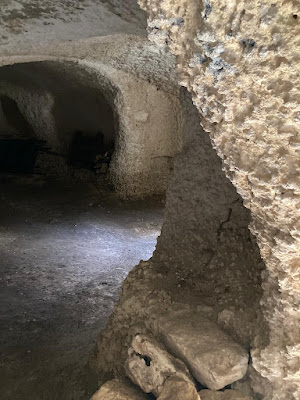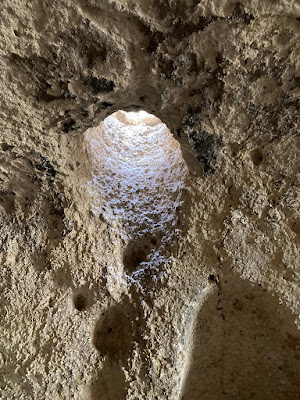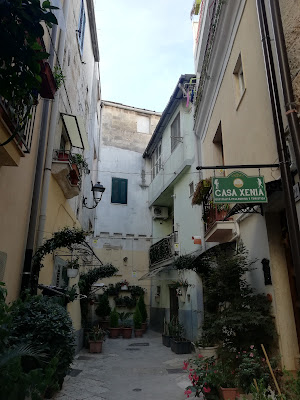We are now in the Alta Murgia, the high Murgia plateau: a sort of steppe characterised by a harsh, barren karstic landscape punctuated by small, fertile cultivated valley floors with drystone walls and buildings.
The "mesetas" of Puglia!
In one of these fertile valleys, we stopped for lunch at Masseria Scalera. We sat at a picnic table in the shade, beside the chicken coop and the sheep fold, dining on Altamura bread and a selection of cheeses made right on the farm. The ricotta was so fresh it was still warm, and the farmer said that if we'd arrived half an hour earlier we would have caught him in the act of making the mozzarella!
 |
| Our phosphorescent fellow walkers from the Nordic Walking Association of Conegliano were also at the farm sampling the cheeses |
When we left Masseria Scalera, our hostess gave us each a length of ribbon in yellow and green, the colours of the Cammino Materano, on which to write a message, or just our names, to attach to the "pilgrim tree" at the entrance to the farm.
We had another ten kilometres to walk after lunch, through the fertile fields and along an ancient cart track through Fornello, a rocky area full of caves.
Geologically speaking, Puglia is almost 80% made up of calcareous and dolomitic rock in various forms. The three major areas of Puglia - Gargano, Murge and Salento - are all characterised by the elements typical of a karstic landscape: sparse vegetation, a surface made up of sharp rocks, and structures such as furrows and dolines, formed by the corrosive and erosive action of water.
In one of these caves, first explored in 1989, a speleological expedition venturing into the most remote and hitherto unexplored corner in 1993 discovered the complete skeleton of an archaic Neanderthal man, dated as 150,000 years old. The man was aged around 32, elderly for the time, and measured 150 cm high, tall for his day. It is thought that he fell into the cave through its narrow opening, attempted to find a way out and then, realising it was impossible to get out again, curled up in this remote corner and waited to die.
The cave of Altamura Man is not open to visitors, because it is extremely difficult to access and because of the fragility of the skeleton, which is still in the place where it was found, covered with mineral accretions from the dripping water in the cave. We visited the Museo dell'Uomo di Altamura, the Museum of Altamura Man, where we watched a 3D video of the site and read all about it.
We explored the streets of the old town centre of Altamura in the chilly evening air, stopping to admire the carved stone portals of the cathedral and the church of San Nicola.
 |
| Sixteenth-century carvings around the door of San Nicola church |
 |
| The main shopping street in Altamura |
 |
| Arco basso, one of the lowest arches in Europe (according to the sign) |
Appropriately enough, right next door was a barber shop that also promised to take care of calluses and other foot problems! It was shut, but with a number posted to call "in the case of need".
 |
| Orecchiette con le rape |
 |
| Cardoncelli, a local vegetable |





































No comments:
Post a Comment